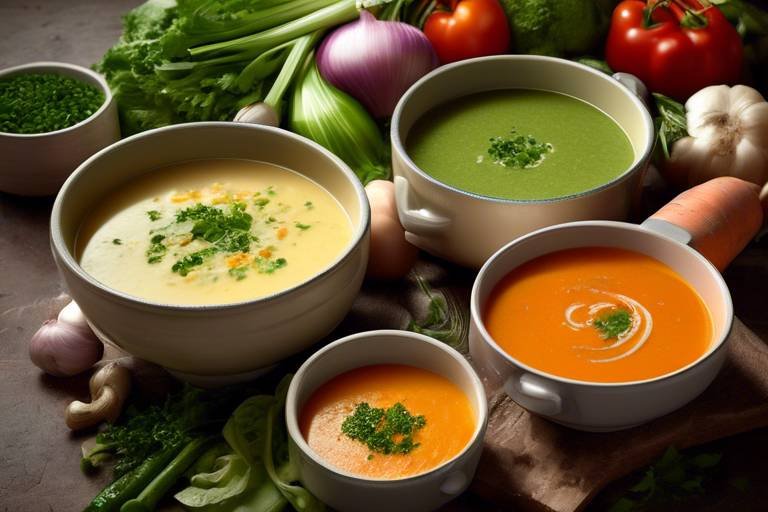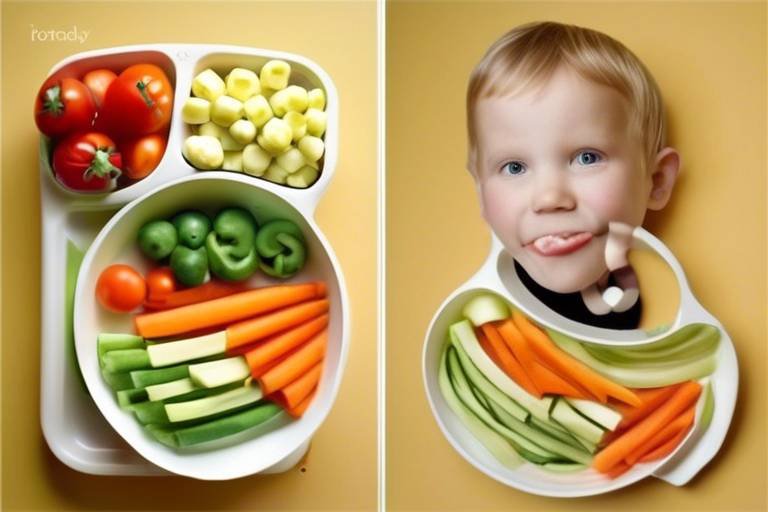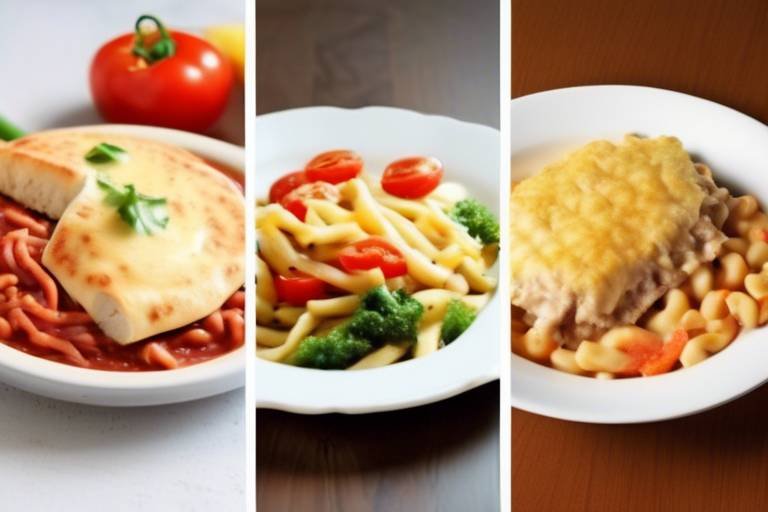Choosing Healthy Snacks for Your Kids
In today's fast-paced world, can feel like a daunting task. With the endless options available, it's easy to get lost in the maze of sugary treats and processed foods that seem to dominate the market. However, healthy snacking is crucial for children's growth and development. It's not just about filling their tummies; it's about fueling their bodies with the right nutrients to support their active lifestyles. So, how do we navigate this snacking landscape to ensure our little ones are getting what they need?
First and foremost, understanding the nutritional needs of children is key. Kids require a variety of nutrients, including vitamins, minerals, proteins, and healthy fats, to thrive. These nutrients play a vital role in their energy levels, concentration, and overall health. For instance, incorporating snacks rich in fiber can aid digestion, while snacks packed with protein can help sustain energy levels throughout the day. Think of their bodies as high-performance engines; they need the right fuel to run efficiently!
Moreover, the benefits of healthy snacking extend beyond just physical health. When children consume nutritious snacks, they are less likely to experience energy crashes, which can lead to irritability and difficulty concentrating. Instead, they enjoy sustained energy that supports their learning and play. By making healthy snacks a regular part of their diet, you are not only helping them maintain energy but also instilling better eating habits that can last a lifetime. Isn’t that a win-win situation?
Regular healthy snacks can also play a significant role in preventing overeating during meals. When children snack strategically throughout the day, they are less likely to arrive at mealtime feeling ravenous, which can lead to unhealthy food choices. Imagine trying to eat a balanced meal when you feel like you could eat a horse! By keeping hunger at bay with nutritious snacks, kids can enjoy their meals without overindulging.
Timing is another crucial factor to consider. Understanding when to offer snacks can maximize their benefits. Ideally, snacks should be provided about 2-3 hours after meals or before engaging in physical activities. This timing helps maintain energy levels and keeps kids focused and alert. For example, a small snack before soccer practice can provide the necessary energy boost without weighing them down.
Another aspect to keep in mind is portion control. Teaching kids about appropriate portion sizes is essential for healthy snacking. Kids often have difficulty gauging how much they should eat, so it’s up to us as parents to guide them. Instead of letting them munch straight from a bag of chips, consider pre-portioning snacks into small containers. This not only helps manage calorie intake but also makes snacking more fun and engaging for them.
Now that we’ve established the importance of healthy snacking, let’s dive into some nutritious options that kids will love. It’s essential to choose snacks that are appealing and meet their dietary needs. Some great options include:
- Fresh fruits like apples, bananas, and berries
- Vegetable sticks with hummus or yogurt dip
- Whole-grain crackers with cheese
- Nut butter on whole-grain toast
- Greek yogurt with honey and granola
Each of these options not only satisfies hunger but also provides essential vitamins and minerals that contribute to overall health. Remember, the goal is to make healthy choices enjoyable!
Now, let’s get creative! Making healthy snacks fun can encourage kids to choose better options. Involving them in the preparation process can also foster a sense of ownership over their food choices. Kids love to get their hands dirty in the kitchen, so why not let them help? Simple tasks like washing fruits, spreading nut butter, or assembling their own yogurt parfaits can make the experience enjoyable and educational.
Additionally, finding healthy snack substitutes for popular but unhealthy snacks can be a game changer. For instance, instead of sugary granola bars, try making homemade energy bites with oats, honey, and nut butter. Swap out potato chips for air-popped popcorn seasoned with a sprinkle of salt or nutritional yeast. These simple swaps can satisfy cravings without the guilt!
Q: How can I encourage my kids to try new healthy snacks?
A: Start by introducing new snacks alongside their favorites. Make it a fun tasting game where they can rate each snack. The more involved they are, the more likely they are to try new things!
Q: What are some quick and easy healthy snack ideas for busy days?
A: Consider pre-packaging snacks like mixed nuts, yogurt cups, or fruit slices in advance. This way, you can grab them on the go without compromising on health.
Q: Are there any snacks I should avoid for my kids?
A: Try to limit snacks high in added sugars, unhealthy fats, and artificial ingredients. Always read labels and opt for whole, minimally processed foods when possible.

Understanding Nutritional Needs
When it comes to our little ones, understanding their nutritional needs is absolutely vital. Children are not just small adults; they have unique requirements that evolve as they grow. Their bodies are in a constant state of development, which means they need a variety of nutrients to support everything from their bones to their brains. Think of it like fueling a race car—if you don’t use the right fuel, the car won’t perform at its best!
Essential nutrients play a significant role in children's overall health and energy levels. Here’s a quick rundown of some key nutrients that are crucial for kids:
- Protein: Essential for growth and repair of tissues. Think of it as the building blocks for their bodies!
- Calcium: Vital for strong bones and teeth. It’s like the cement that holds their structure together.
- Iron: Important for transporting oxygen in the blood. Without it, kids may feel tired and sluggish.
- Vitamins: These are essential for various bodily functions, including immune support and energy production. They’re like tiny superheroes fighting off ailments!
- Fiber: Helps with digestion and keeps kids feeling full. Think of it as a broom that sweeps out the digestive system.
Each of these nutrients plays a unique role in supporting a child’s growth. For instance, protein can be found in foods like chicken, beans, and dairy products, while calcium is abundant in milk and green leafy vegetables. Iron-rich foods include red meat, lentils, and fortified cereals. By offering a variety of foods, parents can ensure their children are getting a balanced intake of these essential nutrients.
Moreover, the way children metabolize food is different from adults. They need more frequent meals and snacks to maintain their energy levels throughout the day. This is where healthy snacking comes into play. Instead of reaching for sugary snacks that provide a quick burst of energy followed by a crash, parents should aim for snacks that are rich in nutrients. This not only helps sustain energy but also supports their growing bodies.
In summary, understanding the nutritional needs of children is about more than just filling their tummies; it’s about providing them with the right fuel to thrive. By focusing on a balanced diet rich in proteins, vitamins, and minerals, parents can help their kids grow up healthy and strong, ready to take on the world!
- What are the best snacks for kids? Look for options like fruits, yogurt, nuts, and whole-grain crackers.
- How often should kids snack? Generally, kids can benefit from healthy snacks every 2-3 hours, depending on their activity levels.
- Can I give my child sweets? Moderation is key! It’s okay to indulge occasionally, but try to balance it with healthier options.

Benefits of Healthy Snacking
This article explores the importance of healthy snacking for children, offering practical tips, nutritious options, and creative ideas to help parents make better snack choices for their kids.
Children have unique nutritional requirements that support their growth and development. This section discusses essential nutrients and how they influence children's health and energy levels.
Healthy snacking is more than just a trend; it’s a vital part of a child’s diet that can lead to numerous positive outcomes. When kids munch on nutritious snacks, they not only fuel their bodies but also enhance their overall well-being. One of the primary benefits is the provision of sustained energy. Instead of experiencing energy crashes that can come from sugary snacks, wholesome options help maintain steady energy levels, allowing children to stay active and engaged throughout the day.
Moreover, healthy snacks can significantly improve concentration. Think about it: when kids are hungry, it’s tough for them to focus on homework or even enjoy playtime. By incorporating nutrient-rich snacks into their routine, parents can help their children stay sharp and attentive, whether in the classroom or at home. For instance, a handful of nuts or a piece of fruit can do wonders for a child’s ability to concentrate on tasks.
Another noteworthy benefit is that healthy snacking promotes better eating habits in the long run. When children regularly consume nutritious snacks, they are more likely to develop a taste for healthy foods, making them less inclined to reach for junk food. This shift not only supports their current health but also sets the foundation for lifelong healthy eating patterns. It's like planting a seed that grows into a tree of good habits!
Regular healthy snacks can also play a crucial role in preventing overeating during meal times. When kids are allowed to snack mindfully throughout the day, they are less likely to arrive at the dinner table feeling famished, which can lead to overeating. Instead, strategic snacking helps curb hunger and makes meals more enjoyable. Think of it this way: just like a car needs fuel to run efficiently, children need regular nourishment to maintain their energy and mood.
Understanding the right times to offer snacks can maximize their benefits. Ideally, snacks should be spaced out throughout the day to keep energy levels stable. For instance, a small snack between breakfast and lunch can help bridge the gap, preventing the dreaded mid-morning slump. This timing ensures that kids remain focused and energetic, ready to tackle whatever comes their way.
Teaching kids about portion sizes is crucial for healthy snacking. It’s easy to overindulge, especially with snacks that are readily available. By educating children on what constitutes a proper portion, parents can help them develop a better understanding of their own hunger cues. A simple way to implement this is by using smaller plates or containers for snacks, which can visually cue kids to eat less without feeling deprived.
Selecting the right snacks is essential for health. This section provides a list of nutritious snack options that appeal to kids and meet their dietary needs.
Making healthy snacks fun can encourage kids to choose better options. This section shares creative and appealing snack ideas that kids will love.
Engaging children in preparing their snacks can foster healthier choices. Here, we discuss ways to involve kids in the kitchen to promote good eating habits.
Finding healthier alternatives to popular snacks can be beneficial. This subsection highlights easy swaps for common unhealthy snacks that kids often crave.
- What are some quick healthy snacks for kids?
Some quick options include yogurt with fruit, sliced veggies with hummus, or whole-grain crackers with cheese.
- How can I encourage my kids to eat healthy snacks?
Involve them in the snack-making process, offer a variety of choices, and make snacks visually appealing.
- Are store-bought healthy snacks a good option?
Yes, but always read labels to ensure they are low in added sugars and high in nutrients.

Preventing Overeating
When it comes to healthy snacking, one of the most significant benefits is its ability to help prevent overeating during meals. Imagine your child as a car; without the right fuel, they simply won’t run efficiently. By providing nutritious snacks at appropriate times, you can keep their energy levels stable, which is crucial for both physical activity and cognitive function. A well-timed snack can act like a pit stop, allowing them to refuel without overloading their systems.
Regular snacking can help curb hunger, making mealtimes more enjoyable and less stressful. When kids are overly hungry, they tend to eat quickly and may not make the best food choices. This can lead to a cycle of unhealthy eating habits that can be hard to break. By offering healthy snacks, you can help your child develop a balanced appetite. Think of it as teaching them to listen to their bodies' hunger cues rather than letting their cravings dictate what they eat.
To maximize the benefits of healthy snacking, consider the following strategies:
- Choose nutrient-dense snacks: Foods rich in fiber, protein, and healthy fats can keep kids full longer.
- Establish a routine: Regular snack times can help regulate appetite and prevent impulsive eating.
- Encourage mindful eating: Teach your children to enjoy their snacks without distractions, which can help them recognize when they’re full.
In addition to these strategies, it's essential to model healthy eating behaviors yourself. Children often mimic their parents' actions, so if they see you enjoying healthy snacks, they are more likely to follow suit. Remember, it’s all about creating a positive environment around food. When kids feel supported and informed about their choices, they are more likely to develop a healthy relationship with food.
In conclusion, preventing overeating isn’t just about what snacks you offer; it’s about how and when you offer them. By being intentional with snacking habits and making nutritious options readily available, you can help your children cultivate a healthier lifestyle that will benefit them for years to come.
Q: How many snacks should my child have each day?
A: It depends on your child's age, activity level, and nutritional needs. Generally, 1-3 healthy snacks between meals can help maintain energy levels.
Q: What are some good snack options for kids?
A: Nutritious options include fruits, vegetables with hummus, yogurt, whole-grain crackers, and nuts. The key is to choose snacks that are high in nutrients and low in added sugars.
Q: How can I encourage my child to choose healthy snacks?
A: Involve them in the snack selection and preparation process. When kids help choose and make their snacks, they are more likely to enjoy them and make healthier choices.
Q: Can snacks replace meals?
A: While snacks can complement meals, they shouldn’t replace them. Healthy snacks should be viewed as additional fuel, not a substitute for balanced meals.

Timing is Key
When it comes to snacking, timing can make all the difference in how your child feels and performs throughout the day. Think of it like a well-timed race; if the runners don't know when to take off, they might miss their chance to shine! Similarly, offering snacks at the right intervals can help keep your child's energy levels steady and their minds sharp. So, what are the ideal snack times? Generally, it's important to consider the rhythm of your child's day. For instance, a mid-morning snack can be a game-changer for kids who have had a long stretch since breakfast. It not only curbs hunger but also gives them a little boost to tackle their morning activities.
Moreover, after-school is another crucial time for snacking. Kids often come home feeling ravenous, and providing a nutritious snack can help them refuel before diving into homework or other activities. You might want to consider snacks that are rich in protein and healthy fats, such as hummus with veggies or yogurt with fruit, to keep them satisfied until dinner. But don’t just stop there! Timing snacks around physical activities can also be beneficial. For instance, if your child has soccer practice after school, a quick snack about 30 minutes before they head out can provide the necessary energy without weighing them down.
In addition to these specific times, it's also essential to listen to your child's hunger cues. Kids may not always wait for the clock to tell them when they're hungry. They might need a snack after a particularly active play session or before a big test at school. By being attuned to their needs, you can help them develop a healthy relationship with food and snacking.
To summarize, here are some key points to keep in mind regarding snack timing:
- Offer a mid-morning snack to bridge the gap between breakfast and lunch.
- Provide an after-school snack to refuel energy levels.
- Consider pre-activity snacks for kids involved in sports or physical activities.
- Pay attention to your child's hunger cues for a more personalized snack schedule.
By mastering the art of timing, you can help your children not only enjoy their snacks but also benefit from them in ways that support their growth and daily activities. After all, healthy snacking isn't just about what they eat; it's also about when they eat it!

Portion Control
When it comes to snacking, is a game changer for kids. It's not just about what they eat, but also how much they eat. Teaching children about portion sizes is crucial because it helps them understand their body's hunger cues and prevents excessive calorie intake. Think of it like a treasure map; if they know the right portions, they can navigate their way to healthy eating without feeling lost in a sea of snacks.
One effective way to teach portion control is by using visual aids. For example, you can show them that a serving of fruit is about the size of a tennis ball, while a serving of cheese is roughly the size of a pair of dice. This makes it easier for kids to visualize what a healthy portion looks like. You can even use colorful plates or snack containers that have portion sizes marked on them to make it a fun and engaging experience.
Moreover, it's essential to encourage kids to listen to their bodies. Instead of saying, “You have to finish everything on your plate,” try asking, “Are you still hungry?” This simple question can empower them to make their own decisions about when to stop eating. By fostering this awareness, you're helping them develop a healthy relationship with food that lasts a lifetime.
To further support portion control, consider implementing a snack schedule. This could involve planning specific times during the day for snacks, which can help regulate their hunger and prevent mindless munching. For instance, if they know they have a snack after school, they may be less likely to overindulge during lunch. Remember, the goal is to create a balanced approach, where snacks are seen as a healthy addition to their meals rather than an afterthought.
Ultimately, teaching kids about portion control is about balance and moderation. It’s not about restricting their favorite foods but rather guiding them to enjoy those treats in a way that supports their health. By instilling these habits early on, you’re equipping them with the tools they need to make smart food choices as they grow. So, let’s embrace portion control as a fun and educational journey that benefits both parents and children alike!
- What are some good portion sizes for kids? A serving of fruit is about the size of a tennis ball, while a serving of veggies is roughly the size of a fist.
- How can I encourage my child to stop eating when they're full? Teach them to listen to their body and ask questions like, "Are you still hungry?"
- What are some fun ways to teach portion control? Use colorful plates with portion sizes marked or create a snack schedule to make it engaging.

Choosing Nutritious Options
When it comes to snacking, the choices you make for your kids can have a profound impact on their overall health and development. It's not just about filling their bellies; it's about providing them with the right fuel to support their active lifestyles. So, what exactly are the nutritious options that can keep your little ones satisfied and energized? Let's dive into some delicious and healthy snack ideas that are sure to please even the pickiest of eaters.
First off, it's important to understand that nutritious snacks should be a balance of carbohydrates, proteins, and healthy fats. This combination not only helps in keeping hunger at bay but also supports their growing bodies and minds. For instance, pairing fruits with nut butter can provide a satisfying mix of sweetness and protein. Imagine the crunch of an apple slice dipped in creamy peanut butter—it's not just tasty, but it also packs a nutritional punch!
Now, let’s take a look at some specific options that parents can easily incorporate into their kids’ diets. Here are a few ideas:
- Fruits and Veggies: Fresh fruits like bananas, berries, or oranges are not only vibrant and appealing but also loaded with vitamins. Pair them with a dip like yogurt or hummus to make them even more enticing.
- Whole Grain Snacks: Whole grain crackers or rice cakes topped with cheese or avocado can be both filling and nutritious. They provide fiber that helps in digestion and keeps kids feeling full longer.
- Yogurt Parfaits: Layering yogurt with granola and fruits can turn a simple snack into a delightful treat. It’s visually appealing and offers a great mix of protein and probiotics.
But wait, there's more! Don't forget about the power of nuts and seeds. These tiny powerhouses are packed with healthy fats and protein, making them an excellent choice for a quick snack. Just be mindful of portion sizes, as they can be calorie-dense. A small handful of almonds or sunflower seeds can go a long way in keeping your kids energized.
Another great option is to get creative with smoothies. Blend up some spinach, banana, and yogurt for a green smoothie that’s both nutritious and delicious. Kids often love the vibrant colors and fun straws, making it a perfect snack to cool down on a hot day. Plus, it’s a sneaky way to get in those veggies!
In summary, choosing nutritious options for your kids doesn't have to be a daunting task. By focusing on a balance of macronutrients and incorporating a variety of colorful fruits, veggies, and whole grains, you can create snacks that are both appealing and beneficial. Remember, the goal is to make healthy snacking a fun and enjoyable experience for your children. After all, when kids are excited about what they eat, they're more likely to make better choices!
Q: How can I encourage my kids to try new healthy snacks?
A: One effective way is to involve them in the snack preparation process. Let them choose a fruit or veggie at the store, and encourage them to help wash or cut it at home. Making snacks together can spark their interest in trying new things!
Q: Are store-bought healthy snacks a good option?
A: Yes, many store-bought snacks are now designed to be healthier alternatives. Just be sure to read the labels for added sugars and preservatives. Look for options that are low in sugar and high in fiber and protein.
Q: How can I manage portion sizes for snacks?
A: Use small bowls or containers to serve snacks, and encourage your kids to take only what they can finish. Teaching them about portion sizes early on can help them develop a healthy relationship with food.

Creative Snack Ideas
When it comes to snacking, kids often gravitate towards options that are colorful, fun, and tasty. Therefore, it’s crucial to think outside the box and get a bit creative! Healthy snacks don’t have to be boring or bland. In fact, making them exciting can encourage children to make better choices. Imagine a plate of vibrant fruits arranged like a rainbow or a fun, interactive snack that requires a bit of assembly. These visual and tactile elements can make a world of difference. So, how can you transform simple ingredients into exciting snacks?
One idea is to create fruit kabobs. Simply take a variety of fruits like strawberries, bananas, and grapes, and let your kids thread them onto skewers. Not only does this provide a healthy dose of vitamins, but it also turns snacking into a fun activity. You could even challenge them to create patterns or color combinations. Another fun option is to make yogurt parfaits. Layer yogurt with granola and fruits in a clear cup. The layers look appealing, and kids will love digging into their own creations!
Another way to make healthy snacks appealing is through themed snacks. For instance, you can create a “garden” by using celery sticks as the “stems” and topping them with peanut butter or cream cheese, then adding raisins as “flowers.” This not only makes for a nutritious snack but also sparks creativity and storytelling. Kids can even help in the kitchen, which fosters a sense of pride and ownership over their food choices.
Additionally, consider using whole grain wraps as a base for various fillings. You can spread hummus or cream cheese and let your kids add their favorite veggies, cheese, or deli meats. Roll it up, slice it into pinwheels, and voilà! You have a fun, nutritious snack that’s easy to eat. These wraps can also be customized to suit your child’s taste preferences, making them more likely to enjoy what they’re eating.
Want to take it a step further? How about creating a DIY trail mix? Set up a station with various nuts, seeds, dried fruits, and a few dark chocolate chips. Let your kids mix and match their favorites. This not only makes for a healthy snack but also teaches them about portion control as they can see how much they’re taking. Plus, it’s a great way to introduce new flavors and textures they might not usually try!
Incorporating healthy snacks into your child's routine doesn't have to be a chore. By presenting them in a fun and engaging way, you can turn snacking into a delightful experience. Remember, the key is to keep it colorful, interactive, and, most importantly, delicious!
1. How can I encourage my kids to eat healthier snacks?
Involve them in the snack preparation process. Let them choose ingredients and help assemble their snacks. When kids have a hand in making their food, they are more likely to eat it!
2. What are some quick healthy snack options for kids?
Some quick options include yogurt with fruit, cheese sticks with whole-grain crackers, or sliced veggies with hummus. These snacks are nutritious and can be prepared in a flash!
3. How can I make snacks more fun for my kids?
Try using cookie cutters to create fun shapes with fruits, veggies, and sandwiches. You can also create themed snacks or involve them in making their own trail mix.
4. Are store-bought snacks okay?
Yes, but be mindful of the ingredients. Look for snacks with whole ingredients, minimal added sugars, and those that are high in fiber and protein. Always check the labels!

Involving Kids in Snack Preparation
Getting your kids involved in snack preparation can be a game-changer when it comes to promoting healthy eating habits. When children participate in the kitchen, they not only learn valuable skills but also develop a sense of ownership over their food choices. Imagine the excitement on their faces when they create their own snacks! It’s like turning the kitchen into a mini cooking show, where they are the stars. Plus, it’s a fantastic way to sneak in some education about nutrition and cooking.
One effective approach is to let your kids choose a snack recipe from a list of healthy options. You can provide them with a selection of ingredients and ask them to come up with their own unique combinations. For instance, if you have fruits, yogurt, and granola on hand, they could create a delicious parfait. This not only encourages creativity but also allows them to experiment with flavors and textures. You might be surprised at the tasty combinations they come up with!
Moreover, involving kids in snack prep can foster teamwork and bonding. Set aside a specific time each week for a “snack prep day,” where the whole family can gather in the kitchen. This can become a fun tradition! During this time, you can discuss the benefits of the ingredients being used, such as how fruits provide vitamins and how whole grains are great for energy. By making it a family affair, you’re instilling healthy habits while creating lasting memories.
Here are some engaging activities you can do together:
- Grocery Shopping: Take your kids grocery shopping and let them pick out fruits and vegetables they want to try. This gives them a sense of control and encourages them to taste new things.
- Measuring Ingredients: Allow them to measure out ingredients for recipes. This not only teaches math skills but also helps them understand portion sizes.
- Decorating Snacks: Let them have fun decorating their snacks. Whether it’s spreading nut butter on apple slices or arranging fruits on a plate, creativity can make healthy eating more appealing.
Involving kids in snack preparation also means teaching them about food safety. Make it a point to discuss the importance of washing hands, cleaning surfaces, and handling food properly. These lessons are invaluable as they grow older and become more independent in the kitchen. It’s not just about making snacks; it’s about building confidence and competence in their culinary skills.
Ultimately, when kids are part of the process, they are more likely to enjoy the snacks they’ve helped create. They’ll feel proud of their contributions and may be more inclined to choose healthy options over sugary, processed snacks. It’s a win-win situation that can lead to healthier eating habits for the entire family!
Q: How can I encourage my child to try new healthy snacks?
A: Involve them in the selection and preparation process. Let them choose from a variety of healthy options and encourage creativity in how they combine ingredients.
Q: What are some easy snacks that kids can prepare themselves?
A: Some great options include fruit and yogurt parfaits, veggie sticks with hummus, or whole grain wraps with their favorite fillings. Simple and fun!
Q: How do I make healthy snacks appealing to my kids?
A: Presentation is key! Use colorful ingredients, fun shapes, and creative arrangements. Allowing kids to decorate their snacks can also make them more appealing.

Healthy Snack Substitutes
When it comes to snacking, kids often gravitate towards options that are convenient but not necessarily healthy. However, the good news is that there are plenty of delicious and nutritious substitutes that can satisfy their cravings without compromising their health. Imagine replacing greasy chips with crispy veggie sticks or sugary candies with naturally sweet fruits! By making these simple swaps, you can transform snack time into a nourishing experience.
For instance, instead of reaching for those traditional potato chips, why not try air-popped popcorn? It's light, crunchy, and can be seasoned with a sprinkle of cheese or nutritional yeast for added flavor. Another fantastic alternative is to swap out sugary granola bars for homemade energy bites made from oats, nut butter, and a touch of honey. These bites are not only easy to prepare but also packed with energy-boosting nutrients that will keep your kids active and focused.
Additionally, consider replacing ice cream with frozen yogurt or fruit smoothies. These options can be just as creamy and satisfying, yet they provide beneficial probiotics and vitamins. You can even involve your kids in the preparation process, allowing them to blend their favorite fruits with yogurt to create a personalized treat. This not only makes snacking fun but also instills a sense of ownership over their food choices.
Here are some more ideas for healthy snack substitutes:
- Instead of cheese puffs, offer cheese cubes or string cheese with whole-grain crackers.
- Swap sugary cereal bars for whole fruit, like apples or bananas, which are naturally sweet and full of fiber.
- Replace chocolate bars with dark chocolate-covered almonds for a sweet treat that also provides healthy fats.
These substitutes not only curb unhealthy cravings but also introduce your children to a variety of flavors and textures that they may not have experienced otherwise. By encouraging them to explore these alternatives, you’re setting them up for a lifetime of healthy eating habits. Remember, the goal is to make snacks enjoyable while also being nutritious, so feel free to get creative and experiment with different combinations!
Q: How can I make healthy snacks appealing to my kids?
A: Presentation is key! Use colorful plates, fun shapes, and let them help in the kitchen. Kids are more likely to eat what they’ve made themselves.
Q: Are there any quick healthy snacks I can prepare on busy days?
A: Absolutely! Options like yogurt with fruit, nut butter on whole-grain toast, or pre-cut veggies with hummus can be prepared in no time.
Q: How can I encourage my kids to try new healthy snacks?
A: Introduce new snacks gradually and pair them with their favorites. You can also create a “snack of the week” challenge to make it exciting!
Frequently Asked Questions
- What are some healthy snacks I can give my kids?
There are plenty of delicious and nutritious options! Consider fruits like apples, bananas, or berries, along with veggies such as carrots or cucumber slices. You can also try yogurt, whole-grain crackers, or nut butter on whole-grain bread. The key is to mix it up and keep it fun!
- How do healthy snacks benefit my child's growth?
Healthy snacks provide essential nutrients that support growth and development. They help maintain energy levels, improve concentration, and can even prevent overeating during meals. Think of snacks as little power-ups that keep your child's body and brain fueled throughout the day!
- What is the best time to offer snacks to my kids?
Timing is everything! Aim to offer snacks about 2-3 hours after meals. This keeps energy levels stable and prevents hunger from turning into crankiness. Just like a well-timed movie, the right snack at the right time can make all the difference!
- How can I teach my kids about portion control?
Start by using smaller plates or bowls for snacks. You can also involve your kids in measuring out portions together, making it a fun activity. Explain that understanding portion sizes helps keep their energy levels balanced, just like filling a gas tank with the right amount of fuel!
- Can involving kids in snack preparation really make a difference?
Absolutely! When kids help in the kitchen, they’re more likely to try new foods and make healthier choices. It’s like giving them a backstage pass to the world of healthy eating. Plus, it’s a great bonding activity that can spark creativity!
- What are some healthy substitutes for popular snacks?
Swapping out unhealthy snacks for healthier alternatives can be a game changer. For example, replace potato chips with air-popped popcorn, or choose dark chocolate instead of candy bars. These small changes can lead to big improvements in nutrition without sacrificing taste!



















